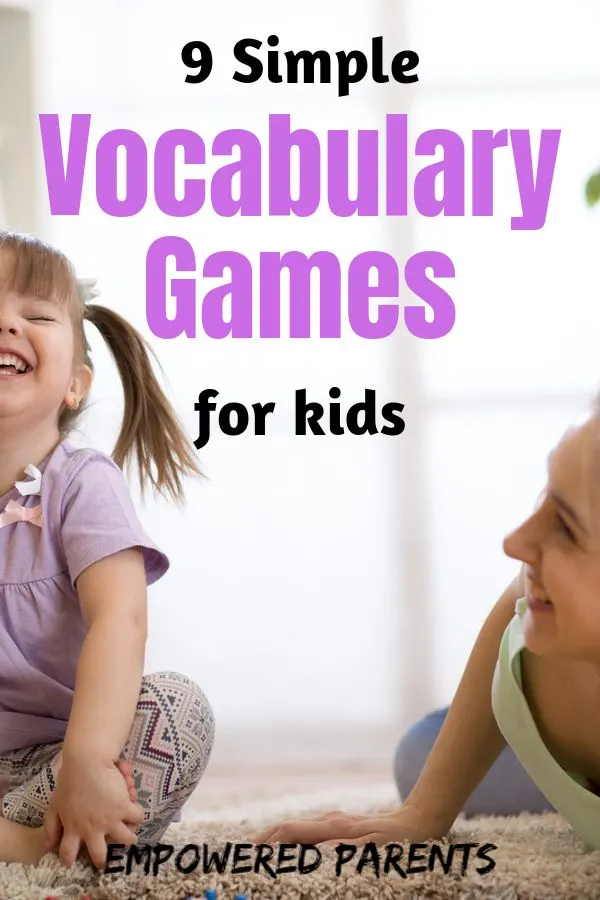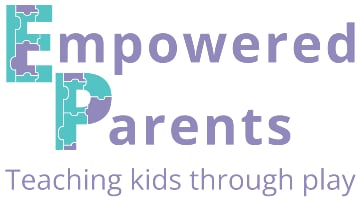Building vocabulary in early childhood is all about exposing children to language – by talking to them, reading to them and generally exposing them to a language-rich environment.
You can also find fun ways to teach vocabulary by planning specific activities, such as playing games or engaging in interactive language activities.
Here are some awesome vocabulary games for kids that are simple and require no prep.
I’ve put together a list of easy games I used to play in my classroom that the kids loved. Play them in class, at home, on the way to school or while doing chores like making dinner together!
My personal favourite is the last game as it is a real challenge.
1. Categories
The Categories Game teaches children new words as well as their meaning, context and the relationship between words.

How to play Categories:
- Choose a category – fruit, kitchen, the zoo, music, clothes, etc.
- Make a long string of words that belong in the category by taking turns adding words.
- Each word may only be said once.
- If you repeat a word, choose a word that doesn’t belong or simply run out of ideas, choose a new category and start again.
- Stay motivated by writing down the record of how many words are in a category and attempt to beat it.
This game is great for teaching children to understand the context of words and how they relate to each other. Words do not live in isolation but work together.
Children may have a good vocabulary of general words but are also able to start developing some theme-specific words that are more unusual in everyday language.
As they grow up and develop more interests they also learn the jargon related to their interests.
While playing this game, try to throw in some interesting, less common words now and again when it is your turn, explaining any words that your children aren’t familiar with.
2. What Am I?
This game is about finding the words to explain something. It will expand your children’s vocabulary of adjectives and verbs.
How to play What am I?
- The children close their eyes and you find any object in the room and hide it behind your back.
- You must describe the object while your children guess what it is.
- Use riddle phrases such as I am long, I am shiny, I am used to eat with, I hold liquids, What am I? (a spoon).
- Give as many clues as you need to until the object is guessed.
- Once a child guesses correctly, it is their turn to hide an object and describe it.
The reason you should go first is to model how to use descriptive phrases without giving away what the object is.
The younger your children, the simpler and more obvious the clues will be that they use but as they get older they will learn how to be more cryptic.
It’s often difficult to see progress in a child while you are teaching them something through play – the progress is noticed with time.
However, this is a game where you will see how quickly your children go from giving very short, obvious clues to using language to describe the texture, colour, size, function, etc.
3. I Spy
The game I spy with my little eye is an old favourite that children love playing. It is a variation of the game above and also teaches children to use language descriptively.

How to play I Spy:
- Begin the game by spotting something in the same room you are playing in.
- Describe the object briefly and let your children guess what it is.
- For example: I spy something that is very small, blue and makes a noise if you shake it.
- Whoever guesses correctly, has a turn to spy on something and let you guess.
To vary this game, only give one set of descriptions and then let your children have as many guesses as necessary.
In the previous game, the object was hidden, whereas in this one the object is in the room and therefore should eventually be spotted. You may want to add one or two last clues if they need some assistance.
The process of guessing and listing the many potential items in the room is also good for building vocabulary.
4. Odd One Out
In a previous game, children made a long list of words in a particular category. Try this game where you now present a list of words and your children have to think of the context of the words and pick out the word that doesn’t fit.

How to play Odd One Out
- Choose a category (without saying it out loud).
- Say a list of 4 or 5 words, all belonging to the category, except one word which should not belong to that category.
- Your children must spot the word that doesn’t belong.
This is not as easy as the previous games because it requires another level of thought.
Because you are not telling your kids what the category is, they have to first listen to all the words and find a common relationship between all but one of them.
You can make this as easy or as difficult as you want, depending on your children’s age and how much they are ready to be challenged.
Here is the difference between an easy round and an advanced round:
- Apple, peach, banana, fish (fruits – fish is the odd word)
- Book, sock, bed, plate, pillow (things found in a bedroom – plate is the odd word)
Here are more Odd One Out game examples.
5. A Bird Flies
Teach your children to use action words (verbs) with this simple vocabulary activity.
How to play A bird flies:
- Choose an animal, person or object (e.g. a bird).
- Ask your kids to think of something a bird does (e.g. a bird flies, a bird chirps, a bird sings, a bird hops).
- Take turns choosing words.
6. What Is It?
This game is a variation of What Am I? It teaches children comprehension skills by making them use the information they have to solve the riddle.
How to play What is it?
- Choose an animal.
- Describe it in a riddle: I’m thinking of something that lives in the sea, has sharp teeth and swims very fast. What is it?
- Whoever guesses the animal, has a turn to choose an animal and make up a riddle.
This game also encourages creative thought as your children have to make up riddles and find interesting ways to explain their animal.
It is best to play this game using the same theme, such as animals, for a few rounds until your kids have learned how to make up a riddle.
Later on, try a different theme such as people at work (e.g. I wear a long coat, I work in a hospital, I sometimes do operations. Who am I?)
7. Once Upon a Time
Making up stories is a great way to develop vocabulary as well as creativity and imagination.

There are 3 ways to make up a story:
1. Using a familiar story
For younger children, use a storybook that they have heard before. Page through the story and take turns to “tell” the story on each page.
Your children will remember some of the story from hearing it before and will use the pictures on the page as clues.
2. Using an unfamiliar story
Use a story with pictures that your children haven’t heard before and page through, taking turns to make up the story by interpreting the pictures.
Follow your kids’ lead and continue the story from their interpretation, while bringing in new ideas and events based on the pictures.
3. Making up a story
Make up a story without a book. This is a great game for the car or for bedtime.
Make up a beginning, such as “Once upon a time there was a little bear in the jungle.” Take turns, adding one line to the story at a time.
I used to play this game often in my classroom and it always got the kids in stitches!
8. Keep It Going
You can play this game anywhere, but the best place is while driving. It’s a great game for learning nouns and thinking fast.
How to play Keep it going:
- As you pass things while driving, take turns naming as many things as you can.
- For example, say “tree, building, sign, traffic light, shop, chair, grass, clouds”, etc.
- Try to keep an unbroken chain of words throughout the trip.
This game is really fun and also requires a lot of thinking. Your children have to really concentrate and think on their toes to not break the continuous stream of words.
I hope you’ve enjoyed these games and activities for developing vocabulary.


Godlove
Friday 8th of January 2021
Very insprirng ideas. keeep it up
Tanja Mcilroy
Saturday 9th of January 2021
Thanks for leaving a comment!
Shalini Agrawal
Friday 21st of August 2020
Thank you for the resources. I loved your ideas and look forward for more such topics related to preschoolers. Thanks for sharing
Tanja Mcilroy
Tuesday 25th of August 2020
You're welcome Shalini. I'm glad these are helpful for you.
Kathy
Sunday 9th of August 2020
Thank you for the resources. I always love your ideas and look forward to what you share. Thanks for sharing.
Tanja Mcilroy
Tuesday 11th of August 2020
Thanks for your kind words Kathy!
ann
Thursday 2nd of July 2020
Thanks Tanja for your great work. It's been very very helpful.
Tanja Mcilroy
Thursday 2nd of July 2020
You're very welcome Ann!
Neha
Saturday 13th of June 2020
thanks for the information.it helps us to involve with children more meaningfully, as i am a speech therapist and a mother of 5 years old girl